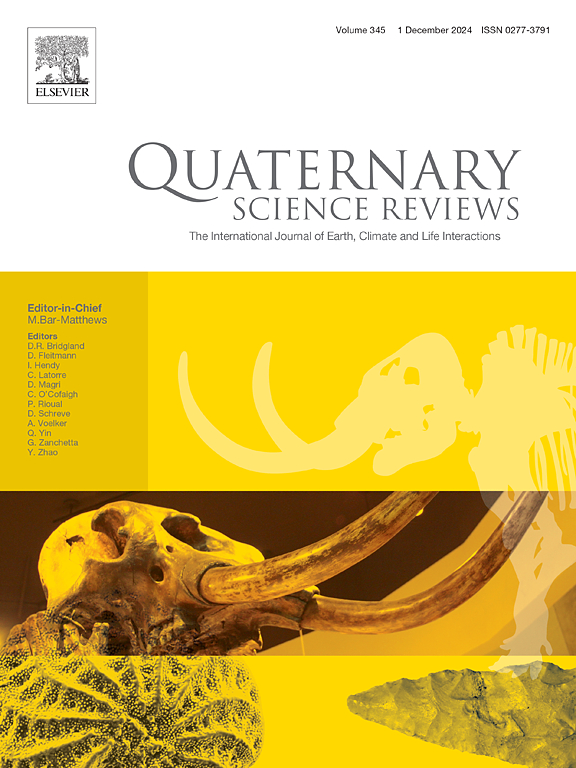Retreat of the Boothia-Lancaster ice stream from its Last Glacial Maximum extent and its role in the origin of Baffin Bay Detrital Carbonate (BBDC) events 0, 1 and 2
IF 3.3
1区 地球科学
Q1 GEOGRAPHY, PHYSICAL
引用次数: 0
Abstract
We combine geomorphological and sediment core evidence to investigate phases of ice margin stability and instability during retreat of the Boothia Lancaster Ice Stream (BLIS) of the NE Laurentide Ice Sheet (LIS) since the Last Glacial Maximum (LGM). Sediment cores 2008029-059 PC and TWC (59CC) and 2013029-064 PC (64 PC) from Lancaster Sound and Baffin Bay, respectively, represent LGM through Holocene environments, including three Baffin Bay Detrital Carbonate (BBDC) events that have been thought to manifest calving events within Lancaster Sound. Previous mapping of glacigenic landforms shows that 64 PC lies within the LGM limit of the convergent BLIS and Tasiujaq Ice Stream (TIS) on the northeastern Baffin Island shelf, while 59CC terminates within subglacial/ice marginal sediments termed the Baffin Shelf Drift (BSD), capturing the history of BLIS retreat from 15.3 cal ka BP onward. In 64 PC, a basal sediment gravity flow deposit is overlain by dolomite-rich BBDC 2, which is re-interpreted here as a subglacial/ice marginal deposit and renamed GZ-BBDC. Both gravity flows are interpreted to have formed during retreat of the confluent TIS and BLIS from the LGM maximum extent. Overlying GZ-BBDC, in 64 PC, is a finely laminated lithofacies interpreted as an ice-shelf facies formed beneath the ice shelf fronting the confluent TIS and BLIS when it occupied a large LGM grounding zone wedge (GZW) in northern Baffin Bay. The ice-shelf facies indicates temporary stabilization of the conjoined TIS and BLIS. The overlying thin black glaciomarine diamicton records disintegration of the ice shelf and retreat of the TIS. Ice retreat over Cretaceous and younger bedrock into Lancaster Sound is recorded by dark brown diamicton and glaciomarine sediments in 59CC. The overlying tan, detrital carbonate-rich glaciomarine diamicton, BBDC 1 in 59 PC, manifests calving retreat of the BLIS onto the Paleozoic carbonate bedrock within Lancaster Sound by 15 cal ka BP. A slightly later onset of BBDC 1 in 64 PC, of ca.14.5 cal ka BP, points to the influence of local conditions such as sea ice and local iceberg calving on the distribution of IRD off of Pond Inlet. The pause in ice rafting and detrital carbonate deposition between BBDC 1 and BBDC 0 within the Younger Dryas chron likely results from BLIS readvance to Devon Island and its stabilization there until 11.6 cal ka BP. BLIS retreat into Prince Regent Inlet marks the onset of BBDC 0. These new results indicate multiple periods of instability of the BLIS, which are responsible for BBDC events identified throughout Baffin Bay.
末次冰期最大期布西亚-兰开斯特冰流的退缩及其在巴芬湾碳酸盐岩碎屑(BBDC)事件0、1和2中的作用
结合地貌和沉积物岩心证据,研究了末次盛冰期(LGM)以来东北劳伦泰冰盖(LIS)布西亚-兰开斯特冰流(BLIS)退缩过程中冰缘稳定和不稳定的阶段。来自兰开斯特湾和巴芬湾的2008029-059 PC和TWC (59CC)以及2013029-064 PC (64 PC)沉积物岩心分别代表了全新世的LGM环境,其中包括三次巴芬湾碎屑碳酸盐岩(BBDC)事件,这些事件被认为是兰开斯特湾内部产裂事件的体现。以往的冰川地貌图谱显示,64 PC位于巴芬岛陆架东北部BLIS和Tasiujaq冰流交汇的LGM范围内,而59CC则终止于被称为巴芬陆架漂移(BSD)的冰下/冰边缘沉积物中,记录了BLIS自15.3 cal ka BP以来的退缩历史。在64pc中,基底沉积重力流沉积被富白云岩的BBDC 2覆盖,重新解释为冰下/冰缘沉积,并更名为GZ-BBDC。这两种重力流都是在汇合处的TIS和BLIS最大程度地从LGM撤退时形成的。64 PC区GZ-BBDC的上覆是一个精细层状岩相,被解释为一个冰架相,形成于面对TIS和BLIS汇合处的冰架之下,当时它占据了巴芬湾北部的一个大型LGM搁浅带楔(GZW)。冰架相表明TIS和BLIS的连接暂时稳定。上覆的黑色薄冰原记录了冰架的解体和TIS的退缩。在白垩纪和更年轻的基岩上的冰退缩进入兰开斯特海峡是由59CC的深棕色沉积物和冰川海洋沉积物记录的。上覆的棕褐色、富含碳酸盐碎屑的冰川海砾岩(BBDC 1)显示了15 cal ka BP的BLIS在兰开斯特湾的古生代碳酸盐基岩上的裂裂后退。BBDC - 1在64年(约14.5 cal ka BP)发生的时间稍晚,表明当地条件(如海冰和当地冰山崩解)对塘口附近IRD分布的影响。在新仙女木期BBDC 1和BBDC 0之间,冰漂流和碎屑碳酸盐沉积的暂停可能是由于BLIS进入德文岛并在那里稳定到11.6 cal ka BP。BLIS撤退到摄政王子湾标志着BBDC 0的开始。这些新的结果表明,BLIS存在多个不稳定时期,这是导致整个巴芬湾发现的BBDC事件的原因。
本文章由计算机程序翻译,如有差异,请以英文原文为准。
求助全文
约1分钟内获得全文
求助全文
来源期刊

Quaternary Science Reviews
地学-地球科学综合
CiteScore
7.50
自引率
15.00%
发文量
388
审稿时长
3 months
期刊介绍:
Quaternary Science Reviews caters for all aspects of Quaternary science, and includes, for example, geology, geomorphology, geography, archaeology, soil science, palaeobotany, palaeontology, palaeoclimatology and the full range of applicable dating methods. The dividing line between what constitutes the review paper and one which contains new original data is not easy to establish, so QSR also publishes papers with new data especially if these perform a review function. All the Quaternary sciences are changing rapidly and subject to re-evaluation as the pace of discovery quickens; thus the diverse but comprehensive role of Quaternary Science Reviews keeps readers abreast of the wider issues relating to new developments in the field.
 求助内容:
求助内容: 应助结果提醒方式:
应助结果提醒方式:


